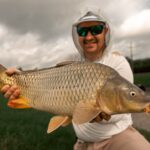
Louisiana Bull Reds Up for Harvest Again: H.B. 604 Must Not Pass
Photo Credit: Carter Abramson | Trevor Johnson Every now and then, we encounter something so
Feature Image: A false albacore being landed off Jupiter Florida by the Cheeky Fishing team, a multi-year sponsor of this research effort.
The latest results from the 2023 Albie Project are available. 2023 was our second season deploying telemetry tags on false albacore in partnership with the Anderson Cabot Center for Ocean Life (New England Aquarium). We held the lofty goal of deploying 97 transmitters in Nantucket Sound in a very short window. Despite the extreme variability of albie season weather, our guides accomplished the task in record time. Their expertise is unmatched and highly appreciated.
The receiver array in Nantucket Sound is robust. The research team pulled the equipment and downloaded the information in early November 2023. One of the intriguing findings from the initial data download was that 11 fish tagged in 2022 had already returned to Nantucket. Documenting these dozen highly efficient swimmers is pretty amazing, considering the battery life of the tags deployed in 2022 was under a year! The newly tagged fish (deployed in ’23) pinged in the Sound from August to November, with some staying until the final day the receivers were removed. These findings present real evidence to support that albies follow a set migration and are a coastal pelagic stock.
Excitingly, we have recently received new data from the coast, as well as data from new offshore receiver arrays that have not been included in previous blogs. This wealth of information, which will be shared with you as soon as possible, will play a pivotal role in guiding us forward as more jurisdictions consider adopting regulations for albies. The interconnected nature of this stock, spanning from Massachusetts to Florida, is becoming increasingly evident, further underscoring the importance of our research.
The diagram included below is often a fan-favorite. Each colored line represents an individual false albacore. These fish love Nantucket Sound, and their migratory pace and range are incredible.
Receiver arrays recorded 91 of the 97 albies tagged in 2023 (~94%). The discrepancy does not mean that the other six fish died upon release. From the data we have collected, several albies captured the year prior never pinged inside Nantucket Sound but were recorded later in other areas along the coast. We also received more information from the Atlantic Cooperative Telemetry Network regarding our first year of tagging. Our initial findings from fish tagged in 2022 found concentrations of albies in North Carolina, Rhode Island, New York and Florida. This new data update filled in many of the gaps. Our “2022 tunnys” made notable appearances from New Jersey to Georgia, with concentrations in South Carolina and Florida’s Treasure Coast. The more time that passes, the more robust our migration database becomes.

The eleven fish that returned to Nantucket Sound within a single tag battery life accumulated serious mileage in less than a calendar year. Nine of these fish made it all the way down to Southern Florida and back. We documented the other two albies enjoying the coastal waters of North Carolina before heading back north. The fastest albie of the whole bunch (should we nickname him Ricky Bobby?) traveled from Florida back to Nantucket Sound in 40 days. That is an 1100-mile “straight line distance” traveled in around a month. These fish are nothing short of incredible. This research provides crucial data showing that we have a connected coastal stock. So, what Florida does with these fish directly impacts your fishing in Massachusetts and Rhode Island.
Furthermore, this information enhances the meaning of the proactive steps North Carolina recently took by approving the first guardrail management for false albacore. You can learn more about that here. We look forward to working with other states to enact more reasonable regulations for this undervalued species.
We now have 97 more fish out running laps around the Atlantic accumulating a wealth of new data and understanding of this important fish. While they swim free terrorizing bait schools and making memories for anglers of all ages and skill-levels, the ASGA team is gearing up for the third year of the Albie Project. Stay tuned for ways to help us continue this important research.

Photo Credit: Carter Abramson | Trevor Johnson Every now and then, we encounter something so

This past weekend, ASGA proudly sponsored the Dirty Carp Tournament in Louisiana — and no, you didn’t misread that.

After years of data pouring in from The Albie Project, advocacy, persistence, and support from

This morning, the Connecticut Environment Committee held a hearing on House Bill 6248, a bill
We rely on our members and donations to keep fighting for a sustainable tomorrow in marine conservation.
GIVE THE GIFT OF FISHERIES CONSERVATION THIS HOLIDAY SEASON. SHOP ASGA GOODS THAT FUND FISHERIES RESEARCH & ADVOCACY CAMPAIGNS
JOIN ASGA IN CALLING FOR CRITICAL MANAGEMENT ACTION AFTER YEARS OF SPAWN FAILURES & POOR MANAGEMENT.
By using this website, you agree to our use of cookies. We use cookies to provide you with a great experience and to help our website run effectively. To learn more, please review our privacy policy.
2 Responses
I fish for Albies on the North Fork of Long Island. Last year 45 trips. 41 fish.
This year zero fish as of Oct 14th. I have an 80 mile round trip. I have quite a few friends with the same results. Many are locals who hit the beach 2 – 3 times per day. 7 days per week. Our east end guides are having the same results
Same results as Ronald as of Nov 16th on the south shore of Long Island (Moriches Inlet). For 2023, it seemed like a long albie season from mid October into November. This year, nothing…still hoping though